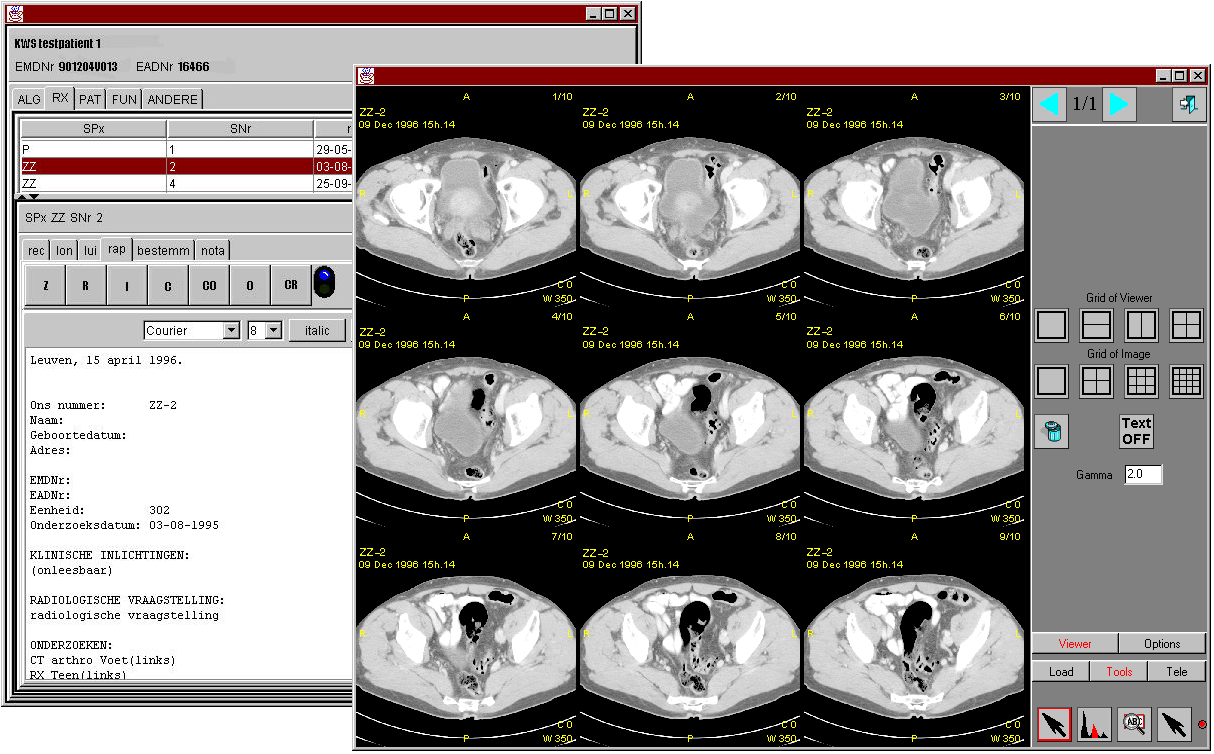
Michel Feron 1,
Erwin Bellon 1, Bart Van den Bosch 2,
Christoph Liekens 2, Werner Aerts 1, Joost Wauters
1, Guy Marchal 1, Paul Suetens 1
1 Medical Image Computing
(ESAT & Radiology)
2 Department of Information Systems, University Hospitals Leuven
Katholieke Universiteit Leuven
Leuven, Belgium
We have re-implemented fundamental building blocks of our RIS in JAVA, building strongly on the paradigm of object orientation. This environment serves as a test bed for the implementation of a future clinical workstation that will be distributed all over the hospital. A key aspect is that this system will implement an integrated view of ‘any’ type of data that will be introduced in the future (including reports, images, lab results, ECG...).
The power of both the technology and the paradigm has been evaluated by integrating a radiological image viewer. This viewer, implemented as a JAVA object, was implemented independently from the base RIS application.
The medical part of the hospital information system of our 2000-bed hospital was developed in-house. Several departmental information systems (including the RIS) as well as the medical workstations for different clinical situations are built upon a common software layer and exploit generic concepts. Focus in the system is on integration over the hospital. The system is centrally managed. Most user interfaces were built using the X Window System.
JAVA and the object orientation paradigm were chosen for different reasons. A first motivation to opt for JAVA is that the installed user workstations are based on different platforms (X terminals, Macintoshes, and PCs).
A second motivation to choose for JAVA is scalability. With hundreds of user workstations, a lot of computing power must be invested in the central servers (the database servers as well as the application servers that implement the business rules). However, JAVA technology allows to shift much of this load to the clients.
This is particularly relevant in a situation were it is important to have high quality and efficient user interfaces (which require a lot of computing resources). This is not only relevant with respect to the tasks of medical users, but has a direct impact on maintenance and support as well. In addition, we had reasons to believe that the JAVA user interface concepts are intrinsically more powerful than the X Window system.
A motivation to radically choose for object orientation is extensibility, or the ability to integrate different types of information in the overall system. This will be detailed in the discussion.
Figure 1 shows a screen dump of the RIS user interface. An important aspect from the ‘PACS’ perspective is the employment of an overall data independent ‘viewer’. This ‘super viewer’ manages layout of and navigation through the individual data-specific viewers. A first advantage is that it is easier to provide a uniform look and feel in the overall user interface and to implement decisions about data presentation.
Figure 1. The JAVA RIS user interface with integration of an independently developed JAVA image viewer.
A second advantage is in data integration. As is also illustrated in Figure 1, one of the ‘sub viewers’ presents radiological image sets. This JAVA image viewer performs all actions specific for presenting and manipulating series of radiological images (including interactive intensity windowing and navigation on an image slice and between image slices). However, this viewer object is under control of the overall system, as well with respect to the data that are to be presented as with respect to overall layout relative to other types of data. The link between RIS and PACS is made by the unique ‘session number’ attributed to each radiological examination. The RIS need not know about the internal structure of an imaging examination.
The JAVA image viewer was developed before the RIS application was. Still, integration of the viewer into the overall system (experimental version) did not even require a few man-days, including discussions about the interface to be implemented.
The JAVA RIS user interface was originally developed on PC (without the viewer, which was developed independently, and this on UNIX and PC simultaneously). The RIS user interface was ported to UNIX without changing a single line of code.
A first purpose in our presentation is to illustrate the potential of JAVA for high-end user interfaces, and to bring up some material with respect to multimedia user interfaces.
A second purpose is to discuss principles for integrating new types of information into the overall information system. We stress that it is possible to make a separation between overall management of information, including images, on the one hand, and data or technology specific functionality on the other hand.
The overall information system (HIS) can manage data supplying objects while taking abstraction from their internal structure. This can be extended to the user interface level. The system we describe can enable information objects to present themselves in a coordinated way. This has consequences on the structure of large information systems and can decrease vulnerability when including non-standardized data types.
Corresponding author:
Erwin Bellon
Medical Image Computing (ESAT & Radiology)
Katholieke Universiteit Leuven
Herestraat 49
B-3000 Leuven, Belgium
Email: erwin.bellon(at)uz.kuleuven.ac.be
Oral presentation at EuroPACS'98, Barcelona, Spain